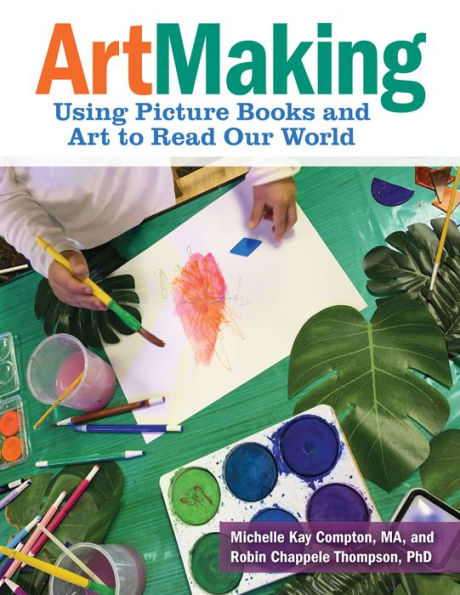ArtMaking: Using Picture Books and Art to Read Our World
From the award-winning authors of StoryMaking and Makerspaces comes ArtMaking.
ArtMaking is a process of making meaning by reading children’s books, investigating how this meaning is expressed and then inviting the child to use art to communicate their own meaning. It is the perfect language to give all children a voice, regardless of age or ability. In ArtMaking children are invited to “read their worlds” as they learn about images, explore materials and elements of art (color, lines, shapes, textures, spaces, design) and communicate their thinking through their own art processes and products. Along the way these skills build a strong literacy foundation.
Using artwork as well as illustrations from children’s books as provocations, children make meaning with their visual literacy skills as they use the receptive and productive languages of literacy and art to make connections. When children engage in ArtMaking they apply the highest level of the comprehension and visual literacy continuums to new art experiences and makerspaces. They aren’t just making art, they are making meaning of the book and the world.
"1139842975"
ArtMaking is a process of making meaning by reading children’s books, investigating how this meaning is expressed and then inviting the child to use art to communicate their own meaning. It is the perfect language to give all children a voice, regardless of age or ability. In ArtMaking children are invited to “read their worlds” as they learn about images, explore materials and elements of art (color, lines, shapes, textures, spaces, design) and communicate their thinking through their own art processes and products. Along the way these skills build a strong literacy foundation.
Using artwork as well as illustrations from children’s books as provocations, children make meaning with their visual literacy skills as they use the receptive and productive languages of literacy and art to make connections. When children engage in ArtMaking they apply the highest level of the comprehension and visual literacy continuums to new art experiences and makerspaces. They aren’t just making art, they are making meaning of the book and the world.
ArtMaking: Using Picture Books and Art to Read Our World
From the award-winning authors of StoryMaking and Makerspaces comes ArtMaking.
ArtMaking is a process of making meaning by reading children’s books, investigating how this meaning is expressed and then inviting the child to use art to communicate their own meaning. It is the perfect language to give all children a voice, regardless of age or ability. In ArtMaking children are invited to “read their worlds” as they learn about images, explore materials and elements of art (color, lines, shapes, textures, spaces, design) and communicate their thinking through their own art processes and products. Along the way these skills build a strong literacy foundation.
Using artwork as well as illustrations from children’s books as provocations, children make meaning with their visual literacy skills as they use the receptive and productive languages of literacy and art to make connections. When children engage in ArtMaking they apply the highest level of the comprehension and visual literacy continuums to new art experiences and makerspaces. They aren’t just making art, they are making meaning of the book and the world.
ArtMaking is a process of making meaning by reading children’s books, investigating how this meaning is expressed and then inviting the child to use art to communicate their own meaning. It is the perfect language to give all children a voice, regardless of age or ability. In ArtMaking children are invited to “read their worlds” as they learn about images, explore materials and elements of art (color, lines, shapes, textures, spaces, design) and communicate their thinking through their own art processes and products. Along the way these skills build a strong literacy foundation.
Using artwork as well as illustrations from children’s books as provocations, children make meaning with their visual literacy skills as they use the receptive and productive languages of literacy and art to make connections. When children engage in ArtMaking they apply the highest level of the comprehension and visual literacy continuums to new art experiences and makerspaces. They aren’t just making art, they are making meaning of the book and the world.
39.95
In Stock
5
1

ArtMaking: Using Picture Books and Art to Read Our World
176
ArtMaking: Using Picture Books and Art to Read Our World
176
39.95
In Stock

Product Details
| ISBN-13: | 9781605547633 |
|---|---|
| Publisher: | Redleaf Press |
| Publication date: | 07/12/2022 |
| Pages: | 176 |
| Sales rank: | 269,089 |
| Product dimensions: | 8.50(w) x 11.00(h) x (d) |
About the Author
From the B&N Reads Blog
